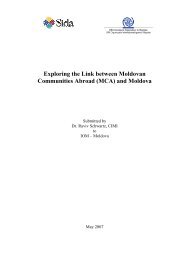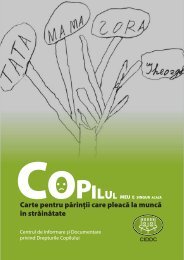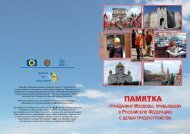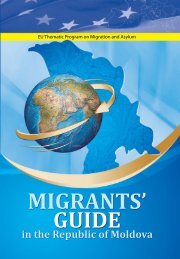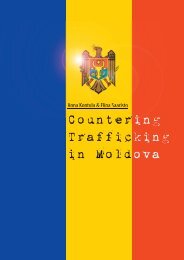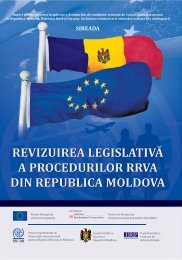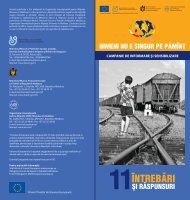Trafficking in Human Beings in Southeastern Europe - Iom
Trafficking in Human Beings in Southeastern Europe - Iom
Trafficking in Human Beings in Southeastern Europe - Iom
- No tags were found...
You also want an ePaper? Increase the reach of your titles
YUMPU automatically turns print PDFs into web optimized ePapers that Google loves.
<strong>Traffick<strong>in</strong>g</strong> <strong>in</strong> <strong>Human</strong> Be<strong>in</strong>gs<strong>in</strong> <strong>Southeastern</strong> <strong>Europe</strong>Republic ofMoldovaand support – a place to stay, psychological and social support, such as hous<strong>in</strong>g,a job, professional tra<strong>in</strong><strong>in</strong>g or school<strong>in</strong>g.A basic service that was offered by Save the Children <strong>in</strong>cluded assistance fromthe airport to the shelter, voluntary STI and HIV/AIDS tests and f<strong>in</strong>ancialassistance to some returned trafficked persons <strong>in</strong> the amount of US$ 150 perperson. Longer term help was offered by Save the Children to 25 percent ofthe returned trafficked persons, but there were no re<strong>in</strong>tegration programmesand the support was very limited – a temporary place <strong>in</strong> a shelter, help withlook<strong>in</strong>g for a job and arrang<strong>in</strong>g medical treatment.Accord<strong>in</strong>g to NGOs, it is estimated that up to 50 percent of trafficked womenwho are returned, leave Moldova shortly after their arrival and are re-trafficked.Without any prospect of a job or means to support themselves andtheir families at home, some women believe that the next time will be betterand that they will be able to work abroad on their own and keep the money,while others simply do not see any other choice.In the second half of 2001, IOM <strong>in</strong> co-operation with a network of local NGOsthroughout Moldova, started a re<strong>in</strong>tegration programme that would provideshelter, social and psychological counsell<strong>in</strong>g, medical services and vocationtra<strong>in</strong><strong>in</strong>g opportunities for return<strong>in</strong>g trafficked persons. The programme wassupposed to be implemented by La Strada, which opened its chapter <strong>in</strong> Moldova<strong>in</strong> May 2001, but <strong>in</strong> the event La Strada had no capacity to manage it.S<strong>in</strong>ce the programme only started <strong>in</strong> September 2001, it is too early to evaluateits effectiveness, although to date, this is one of the few examples ofre<strong>in</strong>tegration programmes <strong>in</strong> the region.1.4. HIV/AIDS and STIsLike other countries <strong>in</strong> Eastern <strong>Europe</strong>, Moldova has witnessed a significant<strong>in</strong>crease <strong>in</strong> sexually transmitted diseases and HIV/AIDS <strong>in</strong> the last few years.The predom<strong>in</strong>ant means of HIV/AIDS transmission <strong>in</strong> Moldova is <strong>in</strong>travenousdrug <strong>in</strong>jection, but there may be a shift towards more sexual transmission <strong>in</strong>the near future. The UN “Common Country Assessment” Report, 46 po<strong>in</strong>ts tothe presence of the follow<strong>in</strong>g negative factors, which will contribute to thespread of HIV/AIDS:• High and <strong>in</strong>creas<strong>in</strong>g rate of illicit drug use;• Consistently high rates of sexually transmitted diseases and tuberculosis;• Grow<strong>in</strong>g unemployment, worsen<strong>in</strong>g standards of liv<strong>in</strong>g and moral values,and prostitution;• High rate of migration of people of reproductive age <strong>in</strong> search of jobsand commercial sex <strong>in</strong>to other countries, especially those with a highprevalence of HIV/AIDS;• Possible growth of the number of HIV-positive children.In 2001, 50 percent of returned trafficked women and girls volunteered tohave STI tests, which were positive <strong>in</strong> 85 percent of cases. Only a quarter ofSTI positive women completed the treatment. There was one positive HIVtest, which has to be repeated.There are no programmes address<strong>in</strong>g the health, <strong>in</strong>clud<strong>in</strong>g HIV/AIDS/STI preventionand treatment, of potential or returned trafficked persons. In 2001 theUN Development programme (UNDP) and the UN Jo<strong>in</strong>t Programme on HIV/2846.Common Country Assessment, UN <strong>in</strong> Moldova, December 2000, p.64-67.



